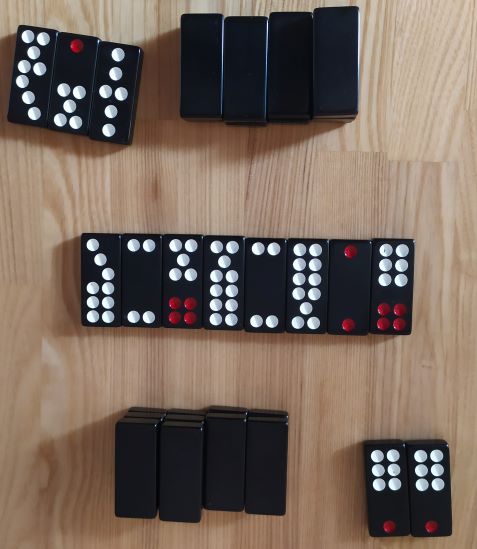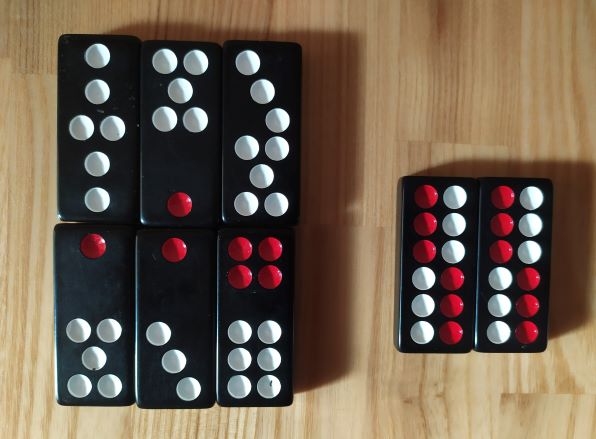TsungShap (對十) – “Dispute for Tens” is a little different from other fishing games. For example, unlike other fishing games, you can catch only “fish” from the two sides of the layout.
Two people play, each gets 16 tiles face down. During the first move, each player takes one of their face-down tile and they place these tiles next to each other on the table. Players take all their tiles face-down and turn them over only during a turn, so they don’t know upfront which tile will be played.

With each subsequent turn, the player takes one of his tiles and adds it to the already existing tiles either to the right or to the left. Next rules apply:
- If his tile is identical to another one already lying on the table to the right or to the left, then he takes both tiles – each spot of such a pair counts for 10 points.
- If his tile combined with the other two extreme tiles (two on the right, two on the left, or one on the right and one on the left) gives a number divisible by ten, he takes all those tiles for himself. These tiles are counted by actual pip count (10, 20 or 30).
- If there were only two tiles on the table and the player took them on his turn, then these three tiles count for 40 points (these tiles must be marked in a special way, for example, put then one on top of the other so that you don’t forget later). After such a move, the table remains empty and the player who made such a move immediately places one of his tiles on the table.
- A player simply places his tile on the right or left if he cannot take tiles on his turn.
- If a player misses an opportunity to take something, his opponent can do it instead.
- As soon as one player runs out of tiles, the game ends and points are counted.

The photo shows an example of a catch – two groups of three, each counting 20 points. Plus one pair of identical tiles, there are a total of 24 dots, multiply by 10, a total of 240. This catch counts for 280 points.
Rules analysis
It is easy to see that this game depends very little on the skill of the player, since the only thing the player can decide is where to put the tile – right or left and most importantly not to miss the opportunity to score points. In addition, the rules are silent on what to do if a player can take the only tile already lying on the table with his tile. It’s not entirely clear why players take 16 tiles each if they can’t look at them anyway, and how come the second player isn’t given the opportunity to end a turn after the first player runs out of dominoes. And it is clear that if the player cleared the table and goes again, then he has fewer tiles left than his opponent.
Since this game was also recorded by Culin, he probably made some mistakes with the rules. This game was probably played a little differently, for example allowing you to clear the table if there was only one tile with its own tile, creating a pair. Probably, the deck was not divided into two, but simply selected tiles from the deck and played until it runs out.
An interesting option is the game described on the German website about dominoes. All the rules are the same, but one important detail is added – each player receives four dominoes at the beginning of the game and can look at them as in usual domino games, plays with them during the game, and after each turn takes one tile from the deck to replenish the hand. This option already gives much more opportunities for strategy, although it is not clear where they got such rules from.
Sources
Description by Culin
German website about dominoes (four tiles in hand variant)